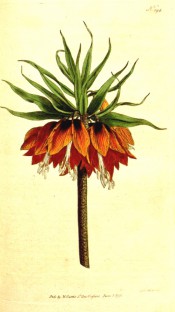Fritillaria imperialis L.
Bulbous perennial with whorls of lance-shaped leaves to 18cm long, and umbels of up to 8 pendant, bell-shaped, orange, yellow or red flowers topped with a cluster of leaf-like bracts. To 1.5m. There are many garden varieties. [RHSE, Hortus].
Horticultural & Botanical History
‘It flowers usually in the beginning of April; the whole plant sends forth a strong, unpleasant smell, compared by most writers to that of a fox, perceptible when you approach it; to this effluvia Parkinson endeavours to reconcile us by saying that it is not unwholesome; it is so disagreeable however, that few choose to have many of these plants, or those in the most frequented parts of their gardens, yet it ought not to be proscribed, for independent of its beauty, there is much in it to admire. […] Luxuriant plants will sometimes produce a second and even a third whorl or crown of flowers, and the flat stalked ones which are monsters, have been known to produce seventy-two blossoms, but none of these are found to be constant. The Crown Imperial, though a native of a much warmer clime than ours, is a hardy bulb, and not very nice in regard to soil, succeeds best in such as is stiffish, enriched with manure, and placed in a sheltered situation.’ Introduced to Britain before 1596 and to Europe somewhat earlier. [BM t.194/1792]. A ‘Yellow crown imperial’ is figured at BM t.1215/1809.
History at Camden Park
Received per ‘Sovereign’ February 1831 as ‘Crown Imperial’. ‘Fritillary’ is also recorded as received per ‘Sovereign’, species not specified. [MP A2948]. These plants probably did not survive as Macarthur requested ‘Crown Imperial’ from J. Abbott of Hobart on 16th June 1846. [MP A2933-2, p.159].
Notes
Published Jan 06, 2010 - 01:21 PM | Last updated Jan 07, 2010 - 01:27 PM
| Family | Liliaceae |
|---|---|
| Category | |
| Region of origin | Turkey to the Himalayas |
| Synonyms | |
| Common Name | Crown imperial |
| Name in the Camden Park Record | Fritillaria imperialis |
| Confidence level | high |


